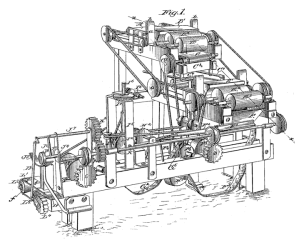In my last blog I explained my theory for what the universe is, what God is, and why all of it exists. In summary, the basis of the universe is the three laws of Aristotelian logic. One law in particular, the Law of the Excluded Middle, requires that every possible proposition be decided. The determinacy of every possible proposition is equivalent to the existence of a universal choice function. I labeled this choice function, appropriately, as God.
However, an inevitable consequence of this particular model of the universe is that everything is part of the choice function, a part of God. The question, then, is how could God create something that is not God and not under the strict control of God’s will.
Suppose we think of God as a space. In at least some sense, almost everything is a space. For example, we refer to the connection between the world’s computers as cyberspace. We typically think of a space as having dimensions. According to a prevailing theory of the known universe, M-Theory, the universe has at least eleven dimensions. If God is a space and he has more dimensions than the known universe, then God may have at least twelve dimensions. How can a space that is effectively everything, and in control of everything, create something that is not part of itself and not under its direct control?
Suppose we think of God as a space and we visualize this space as a piece of paper. If we cut a piece of paper in half and place the two halves together, something remarkable appears. There is a new thing created that is neither the piece of paper on one side of the cut nor the piece of paper on the other side of the cut. The new thing that is created is a one-lower-dimensional space, the cut between them.
This is not merely a property of two-dimensional spaces like paper. It is a property of higher dimensional spaces as well. Suppose we have a fluid separated into two different fluids. Once again, the result is a one-lower-dimensional space. In this illustration, two fluids are depicted. One is oil and the other is water. Of course, oil and water do not mix, so they remain separate and create a one-lower-dimensional space.
(Note: In order for this process to work in a strict mathematical sense, God would need to be a metric space and the separated parts would need to be relatively closed disjoint sets. Since God is, in some sense, his own creator, this does not appear to be an unreasonable specification. This still leaves the problem of what happens to the metric when the two parts are separated. Keep in mind that this is a model and not a rigorous proof.)
This second example raises an obvious question about separating spaces in this way. What keeps them apart? In the case of the paper, they are kept apart by a broken chemical bond. In the case of the oil and water, they are kept apart by cohesion and different weights. In every case, there has to be something that holds them apart.
A model, which I will be proposing very shortly, that goes further to illustrate the process, might be the separation of water into its two constituent elements oxygen and hydrogen. When water is separated into these elements, it forms two gasses that have different weights. If the gasses are separated in a tank, the hydrogen will move to the top and the oxygen will move to the bottom. The separation will not be as clean and complete as the separation of oil and water, but the essential idea is the same.
Suppose the universal choice function, God, created a one-lower-dimensional space by separating into two different substances in a manner analogous to the separation of water into oxygen and hydrogen. This brings to mind the concepts in various philosophies of God having a dual nature. Of course, these different natures are often thought of as good versus evil, but that is not the only interpretation. There is also the concepts of Yin and Yang. If we allow the possibility of three different spaces, there is the Father, the Son, and the Holy Spirit. Perhaps some echo of how our universe came to be is represented in these multi-nature concepts. My point, however, is that the separation might be maintained by having parts that are somehow antagonistic to each other.
If God created a one-lower-dimensional space in this manner, he would have succeeded only in creating a one-lower-dimensional god. The space would be occupied with a choice function similar to the original but, somehow, more limited. Of course, this notion brings to mind the Gnostic concept of the Demiurge. Here again, we may be seeing some echo of the early universe.
In order to limit the possibilities for this one-lower-dimensional space, God may have twisted and folded it and added in some other peculiarities. It can be observed that the eleven dimensions of known space described in M-Theory are twisted and folded in this manner. Specifically, they are twisted and folded into what are called Calabi–Yau Manifolds. Of course, any modification of the one-lower-dimensional space would have to be made while effectively remaining outside of it. The actual twists and folds would have to be implemented in the surrounding spaces.
By moderating the limitations he placed on this space, God could have automatically instilled a particularly useful quality: randomness. It is well understood in quantum mechanics that the motion of particles incorporates a certain randomness. An electron can be visualized as popping in and out of real space at random locations around an atomic nucleus.
Suppose God wanted to have a way of influencing the course of this one-lower-dimensional space without leaving any trace of interference. What better way than to have a random quality that could be tweaked just a bit here and there to change the outcome. It is well established in the science of dynamical systems that small changes in initial conditions can cause dramatic long-term effects. An omniscient and omnipotent God could easily make very slight statistically nonexistent alterations that would completely change the outcome.
There would be another less obvious advantage to incorporating randomness into this space. It would be possible for extra-spatial structures of various sorts to exert an influence. There is one structure, in particular, that is of interest. As I previously stated, if this space was properly structured, choice functions on the level of a one-lower-dimensional god could not form. However, simpler and much more limited choice functions might form to resolve some very limited indeterminacies. These structures might include human consciousness.
We can think of the more or less determinate aspect of this space as being endowed with what we consider ordinary physics. Within the ordinary physics of this space, logical structures might form along the lines of intelligent biological entities: the brains of living creatures. These structures might be expected to take advantage of any and all resources available to them in order to evolve quickly into the most effective logical structures possible. One resource available to them would be the randomness of quantum mechanics and the aforementioned accompanying properties. These biological structures might evolve loose ends in their logical structures in order to take advantage of this randomness. The randomness of quantum mechanics, combined with the ability for limited choice functions to form, could be expected to complete these structures. This kind of “completion” could explain the human experience of consciousness.
You can now, perhaps, see why I titled this entry “The Universe as Puppet Theatre.” While the universe is, in many respects, independent of God, he has incorporated into it a method of influencing the outcome. In a sense, God is a great puppeteer who pulls some, but not all, of the strings that direct the universe along a specified path. Since the universe would be a one-lower-dimensional space formed between spaces of God, he would effectively be everywhere at all times. He would be equally in contact with every point of our space.
You may also note that I have adopted the convention of referring to God with the pronoun “he”. This is not because I consider God to be entirely masculine. In fact, the two parts of God that I describe as existing in separation might very well be masculine and feminine. It is compelling to think that our universe might be a one-lower-dimensional space that exists in constant contact with and is sandwiched between entirely masculine and entirely feminine entities. The use of the pronoun “he” is merely a grammatical convention. I do not find the constant use of “he or she” or deference to the pronoun “she” to be particularly enlightened or beneficial. Our culture should be past the point of deliberately crippling our language in order to make some group of people feel more secure in their identities. I may discuss this topic in more detail in a later blog.
In a future entry, I will explain how the completing structures I have alluded to might actually work and how they could interact with biological brains without revealing their existence and influence in any traceable manner.









